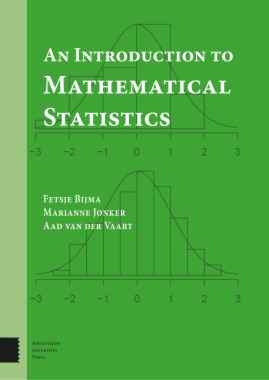Statistics is the science that focuses on drawing conclusions from data, by modeling and analyzing the data using probabilistic models. In 'An Introduction to Mathematical Statistics' the authors describe key concepts from statistics and give a mathematical basis for important statistical methods. Much attention is paid to the sound application of those methods to data.
The three main topics in statistics are estimators, tests, and confidence regions. The authors illustrate these in many examples, with a separate chapter on regression models, including linear regression and analysis of variance. They also discuss the optimality of estimators and tests, as well as the selection of the best-fitting model.Each chapter ends with a case study in which the described statistical methods are applied.
This book assumes a basic knowledge of probability theory, calculus, and linear algebra.
- Cover
- Table of Contents
- 1. Introduction
- 1.1. What Is Statistics?
- 1.2. Statistical Models
- Exercises
- Application: Cox Regression
- 2. Descriptive Statistics
- 2.1. Introduction
- 2.2. Univariate Samples
- 2.3. Correlation
- 2.4. Summary
- Exercises
- Application: Benford’s Law
- 3. Estimators
- 3.1. Introduction
- 3.2. Mean Square Error
- 3.3. Maximum Likelihood Estimators
- 3.4. Method of Moments Estimators
- 3.5. Bayes Estimators
- 3.6. M-Estimators
- 3.7. Summary
- Exercises
- Application: Twin Studies
- 4. Hypothesis Testing
- 4.1. Introduction
- 4.2. Null Hypothesis and Alternative Hypothesis
- 4.3. Sample Size and Critical Region
- 4.4. Testing with p-Values
- 4.5. Statistical Significance
- 4.6. Some Standard Tests
- 4.7. Likelihood Ratio Tests
- 4.8. Score and Wald Tests
- 4.9. Multiple Testing
- 4.10. Summary
- Exercises
- Application: Shares According to Black–Scholes
- 5. Confidence Regions
- 5.1. Introduction
- 5.2. Interpretation of a Confidence Region
- 5.3. Pivots and Near-Pivots
- 5.4. Maximum Likelihood Estimators as Near-Pivots
- 5.5. Confidence Regions and Tests
- 5.6. Likelihood Ratio Regions
- 5.7. Bayesian Confidence Regions
- 5.8. Summary
- Exercises
- Application: The Salk Vaccine
- 6. Optimality Theory
- 6.1. Introduction
- 6.2. Sufficient Statistics
- 6.3. Estimation Theory
- 6.4. Testing Theory
- 6.5. Summary
- Exercises
- Application: High Water in Limburg
- 7. Regression Models
- 7.1. Introduction
- 7.2. Linear Regression
- 7.3. Analysis of Variance
- 7.4. Nonlinear and Nonparametric Regression
- 7.5. Classification
- 7.6. Cox Regression Model
- 7.7. Mixed Models
- 7.8. Summary
- Exercises
- Application: Regression Models and Causality
- 8. Model Selection
- 8.1. Introduction
- 8.2. Goal of Model Selection
- 8.3. Test Methods
- 8.4. Penalty Methods
- 8.5. Bayesian Model Selection
- 8.6. Cross-Validation
- 8.7. Post-Model Selection Analysis
- 8.8. Summary
- Application: Air Pollution
- A. Probability Theory
- A.1. Introduction
- A.2. Distributions
- A.3. Expectation and Variance
- A.4. Standard Distributions
- A.5. Multivariate and Marginal Distributions
- A.6. Independence and Conditioning
- A.7. Limit Theorems and the Normal Approximation
- Exercises
- B. Multivariate Normal Distribution
- B.1. Introduction
- B.2. Covariance Matrices
- B.3. Definition and Basic Properties
- B.4. Conditional Distributions
- B.5. Multivariate Central Limit Theorem
- B.6. Derived Distributions
- C. Tables
- C.1. Normal Distribution
- C.2. t-Distribution
- C.3. Chi-Square Distribution
- C.4. Binomial Distribution (n = 10)
- D. Answersto Exercises
- Index

